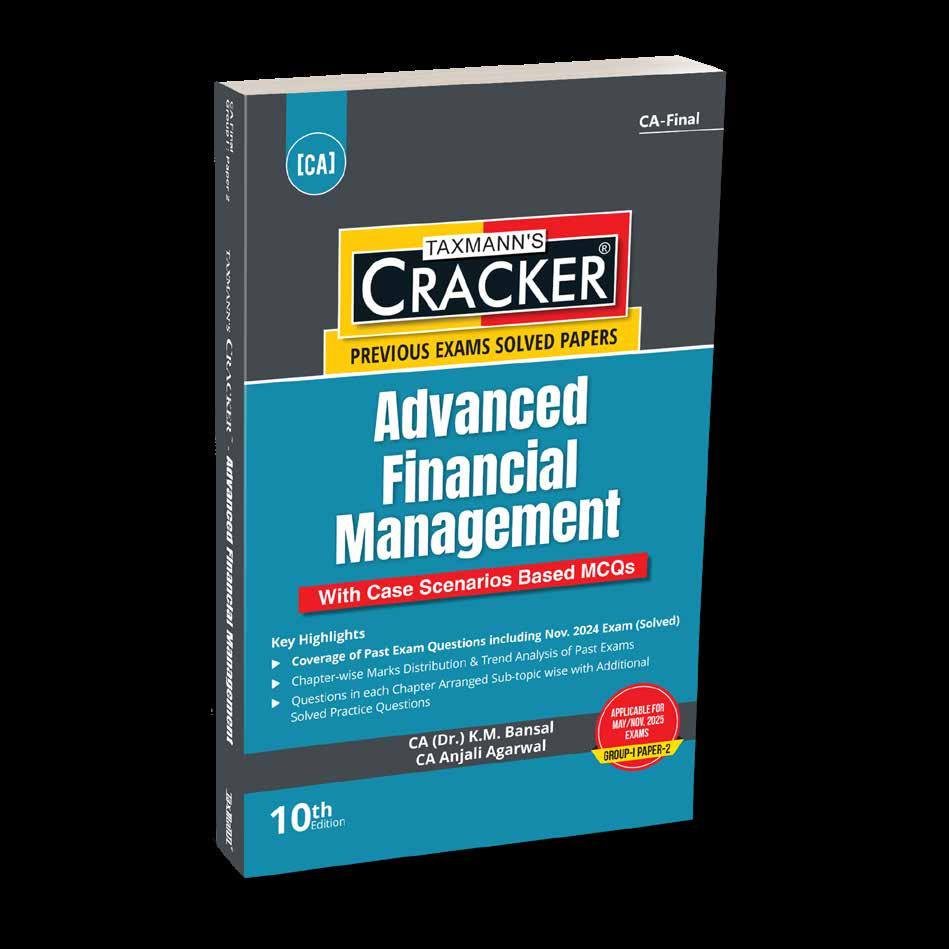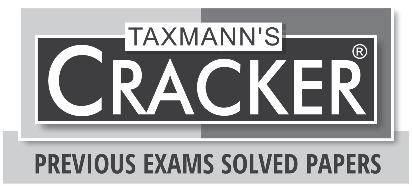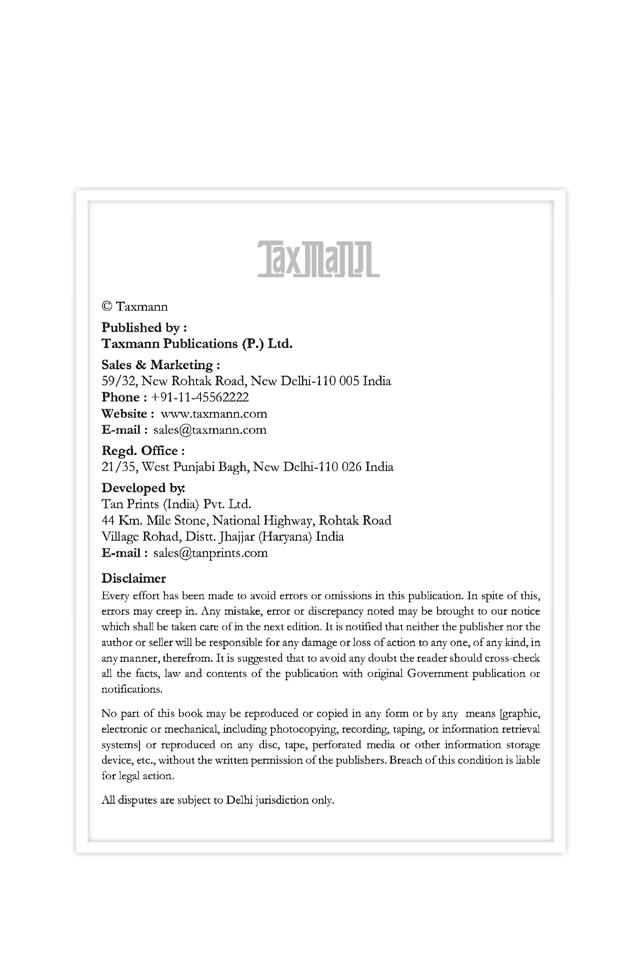










Q.1 Mr. Ram is holding the following securities :
Calculate :
(i) Expected rate of return in each case, using the Capital Asset Pricing Model (CAPM).
(ii) Average rate of return, if risk free rate of return is 14%. [Nov. 2013] [8 Marks]
Ans.: Since, the market return is missing in the question, which is required to calculate the expected return of each security on the basis of CAPM, therefore, assuming the investments to be representing the market, rst, average return on this portfolio is calculated.
(i) Expected Rate of Return
Now, taking 16.84% as market return the Rate of Return of each security using CAPM
= Rf + B (Rm - Rf)
(ii) Expected Average Return of Portfolio (Based on simple average)
Alternatively, It may also be calculated by first finding average Beta and then applying CAPM
Q.2 An investor is holding 5,000 shares of X Ltd. Current year dividend rate is ` 3/share. Market price of the share is ` 40 each. The investor is concerned about several factors which are likely to change during the next nancial year as indicated below:
In view of the above, advise whether the investor should buy, hold or sell the shares. [Nov. 2014] [6 Marks]
Ans. The Investor should take the decision to buy, hold or sell the shares on the basis of change in price and rate of return.
Existing rate of return
= Rf + Beta (Rm - Rf)
= 12% + 1.3 (5%) = 18.5%
Revised rate of return = 10% + 1.4 (4%) = 15.60%
Price of share (original)
Price of share (Revised) P0 = 2.50(1.07)2.675 0.1560.070.086 = = ` 31.10
The current market price of share is ` 40. It is higher in comparison to current equilibrium price of ` 34.42 and revised equity price of ` 31.10. Under this situation investor should sell the share.
Q.3 Mr. Shyam is holding the following securities:
Average return of the portfolio is 15.7%, calculate:
(i) Expected rate of return in each, using the Capital Asset Pricing Model (CAPM).
(ii) Risk free rate of return. [May 2015] [8 Marks] Ans.
(34500 – 36000) Total 75,000 7,025 5,500
(i) Average rate of return on market portfolio
DividendEarnedCapitalappreciation Initialinvestment + × = `` ` 7,0255,500 10016.7% 75,000 + ×=
Rate of Return of each security using CAPM = Rf + B (Rm - Rf)
Note: The risk free rate is required to be calculated for the solution. As this is asked in the second part of the question, the figure of 14.69% has been taken from there.
Gold Ltd. = 14.69 + 0.6 (16.7 - 14.69) = 15.90% Silver Ltd. = 14.69 + 0.8 (16.7 - 14.69) = 16.30%
6.4
Bronze Ltd. = 14.69 + 0.6 (16.7 - 14.69) = 15.90%
GOL Bonds = 14.69 + 0.01 (16.7 - 14.69) = 14.72%
(ii) Risk free return
Simple Average of Beta = 0.60.80.60.01 4 +++ = 0.5025
Average return = Risk free return + Average Beta (Market return - Risk free return)
15.7 = Risk free return + 0.5025 (16.7 - Risk free return)
Risk free return = 14.69%
Q.4 Following are the details of a portfolio consisting of three shares:
Standard Deviation of Market Portfolio Returns = 10%
You are given the following additional data:
Covariance (A, B) = 0.030
Covariance (A, C) = 0.020
Covariance (B, C) = 0.040
Calculate the following:
(i) The Portfolio Beta
(ii) Residual variance of each of the three shares
(iii) Portfolio variance using Sharpe Index Model
(iv) Portfolio variance (on the basis of modern portfolio theory given by Markowitz) [May 2015] [8 Marks]
Ans.:
(i) Portfolio Beta [It is the weighted average of Beta]
0.20 × 0.40 + 0.50 × 0.50 + 0.30 × 1.10 = 0.66
(ii) Residual Variance or unsystematic risk
To determine Residual Variance first of all we shall compute the Systematic Risk as follows:
22 AM × βσ = (0.40)2 (0.1)2 = 0.0016
22 BM × βσ = (0.50)2 (0.1)2 = 0.0025
22 CM × βσ = (1.10)2 (0.1)2 = 0.0121
Residual Variance (Total risk - Systematic risk)
A 0.015 - 0.0016 = 0.0134
B 0.025 - 0.0025 = 0.0225
C 0.100 - 0.0121 = 0.0879
(iii) Portfolio variance using Sharpe Index Model
Systematic Variance of Portfolio = 22 pM × βσ (0.66)2 × (0.10)2= 0.004356
The unsystematic variance of the portfolio is the weighted average of individual residual variance of securities in the portfolio.
Unsystematic Variance of Portfolio = (0.0134) × (0.20)2 + 0.0225 × (0.50)2 + 0.0879 × (0.30)2 = 0.014072
Total Variance = 0.004356 + 0.014072 = 0.018428
(iv) Portfolio variance on the basis of Markowitz Theory
= (WA × WA × 2 Aσ ) (WA × WB × COVAB) + (WA × WC × CovAC) + (WB × WA × CovAB) + (WB × WB × 2 Bσ ) + (WB × WC × CovBC) + (WC × WA × CovCA) + (WC × WB × CovCB) + (WC × WC × 2 Bσ ) = (0.20 × 0.20 × 0.015) + (0.20 × 0.50 × 0.030) + (0.20 × 0.30 × 0.020) + (0.20 × 0.50 × 0.030) + (0.50 × 0.50 × 0.025) + (0.50 × 0.30 × 0.040) + (0.30 × 0.20 × 0.020) + (0.30 × 0.50 × 0.040) + (0.30× 0.30 × 0.10)
= 0.0006 + 0.0030 + 0.0012 + 0.0030 + 0.00625 + 0.0060 +0.0012 + 0.0060 + 0.0090
= 0.0363
Q.5 (a) Mr. Abhishek is interested in investing ` 2,00,000 for which he is considering following three alternatives:
(i) Invest ` 2,00,000 in Mutual Fund X (MFX)
(ii) Invest ` 2,00,000 in Mutual Fund Y (MFY)
(iii) Invest ` 1,20,000 in Mutual Fund X (MFX) and ` 80,000 in Mutual Fund Y (MFY)
Average annual return earned by MFX and MFY is 15% and 14% respectively. Risk free rate of return is 10% and market rate of return is 12%.
(b) Covariance of returns of MFX, MFY and market portfolio Mix are as follow:
You are required to calculate:
(i) variance of return from MFX, MFY and market return, (ii) portfolio return, beta, portfolio variance and portfolio standard deviation, (iii) expected return, systematic risk and unsystematic risk; and (iv) Sharpe ratio, Treynor ratio and Alpha of MFX, MFY and Portfolio Mix. [May 2016] [Nov. 2016] [8 Marks]
Ans.:
(i) Variance of Returns
Corii,j = (,) ij Covij σσ
Accordingly, for MFX
1 = (,)
xx CovXX σσ
2 xσ = 4.800
Accordingly, for MFY
1 = (,) yy CovYY σσ
2 yσ = 4.250
Accordingly, for Market Return
1 = (,) MM CovMM σσ
2 Mσ = 3.100
(ii) Portfolio return beta, variance and standard deviation
Weight of MFX in portfolio = 1,20,000 2,00,000 = 0.60
Weight of MFY in portfolio = 80,000 2,00,000 = 0.40
Accordingly Portfolio Return
0.60 × 15% + 0.40 × 14% = 14.60%
Beta of each Fund = (,) CovFundMarket VarianceofMarket
x = 3.370 3.100 = 1.087
y = 2.800 3.100 = 0.903
Portfolio Beta
0.60 × 1.087 + 0.40 × 0.903 = 1.013
Portfolio Variance using Markowitz Model
= (0.60)2 (4.800) + (0.40)2 (4.250) + 2(0.60) (0.40) (4.300) = 4.472
Or Portfolio Standard Deviation
xyσ = 4.472 = 2.115
(iii) Expected Return, Systematic and Unsystematic Risk of Portfolio
Portfolio Return = 10% + 1.0134 (12% - 10%) = 12.03%
MF X Return = 10% + 1.087 (12% - 10%) = 12.17%
MF Y Return = 10% + 0.903 (12% - 10%) = 11.81%
Systematic Risk = 22βσ Accordingly,
Systematic Risk of MFX = (1.087)2 × 3.10 = 3.663
Systematic Risk of MFY = (0.903)2 × 3.10 = 2.528
Systematic Risk of Portfolio = (1.013)2 × 3.10= 3.181
Unsystematic Risk = Total Risk - Systematic Risk Accordingly,
Unsystematic Risk of MFX = 4.80 - 3.663 = 1.137
Unsystematic Risk of MFY = 4.250 - 2.528 = 1.722
Unsystematic Risk of Portfolio = 4.472 - 3.181 = 1.291
(iv) Sharpe and Treynor Ratios and Alpha
Sharpe Ratio :- MFXF RR σ
MFX = 15%10% 4.800 = 2.282
MFY = 14%10% 4.250 = 1.94
6.8 PORTFOLIO MANAGEMENT
Portfolio = 14.6%10% 2.115 = 2.175
Treynor Ratio :- RRSF β
= 15%10% 1.087 = 4.60
= 14%10% 0.903 = 4.43
= 14.6%10% 1.0134 = 4.54
Alpha Actual Return – Expected MFX = 15% - 12.17% = 2.83%
= 14% - 11.81% = 2.19% Portfolio = 14.6% - 12.03% = 2.57%
Q.6 The following information is available in respect of Security A
cient of Correlation
You are required to determine the Standard Deviation of Market Return and Security Return. [Nov. 2016] [5 Marks]
Ans. First we shall compute the of Security A Since, 6% treasury bond is trading at ` 120, therefore, Risk Free Rate = 6 120 CouponPayment CurrentMarketPrice = = 5%
Assuming equilibrium return to be equal to CAPM return then:
12% = Rf + A (Rm - Rf) 12% = 5% + A (12% - 5%)
Solving for A: A = 1 (i) Standard Deviation of Market Return , 22 196% 1 Am A mm Cov β===
2 196% m σ=
(ii) Standard Deviation of Security Return
Q.7 The returns and market portfolio for a period of four years are as under:
For stock B, you are required to determine: (i) characteristic line; and (ii) the Systematic and Unsystematic risk. [Nov. 2016] [8 Marks]
Ans.:
(i) Characteristic line of stock B
Y= a + bX
a = y bx = 8.5 - (0.74 × 6.5) = 3.69
Characteristic line y = 3.69 + 0.74 Rm
(ii) The Systematic and Unsystematic Risk
Variance approach
Total Risk of stock B 11.25%
Systematic Risk
Unsystematic Risk
22 m × βσ = (0.74)2 × 19.25 = 10.54
Total risk-systematic risk= 0.71% (11.25% – 10.54%)
Q.8 Details about portfolio of shares of an investor is as below:
The investor thinks that the risk of portfolio is very high and wants to reduce the portfolio beta to 0.91. He is considering two below mentioned alternative strategies:
(i) Dispose off a part of his existing portfolio to acquire risk free securities, or
(ii) Take appropriate position on Nifty Futures which are currently traded at ` 8,125 and each Nifty points is worth ` 200.
You are required to determine:
(1) portfolio beta,
(2) the value of risk free securities to be acquired,
(3) the number of shares of each company to be disposed off,
(4) the number of Nifty contracts to be bought/sold; and
(5) the value of portfolio beta for 2% rise in Nifty. [Nov. 2016] [8 Marks]
Ans.: Alternative 1 to dispose part of his existing Portfolio.
AUTHOR : K.M. Bansal, Anjali Agarwal
PUBLISHER : TAXMANN
DATE OF PUBLICATION : JANUARY 2025
EDITION : 10TH EDITION
ISBN NO : 9789364557856
NO. OF PAGES : 520
BINDING TYPE : PAPERBACK


This book is designed exclusively for the Final Level of the Chartered Accountancy Examination. It comprehensively covers past exam questions with detailed answers, adhering strictly to the new scheme of ICAI.
The Present Publication is the 10th Edition for CA-Final | New Syllabus | May/Nov. 2025 Exams. This book is authored by CA. (Dr) K.M. Bansal & CA. Anjali Agarwal, with the following noteworthy features:
• Strictly as per the New Syllabus of ICAI
• [Extensive Coverage] including:
o All Past Exam Questions and Answers, incorporating:
CA Final | Nov. 2024 Exam
o Additional Solved Practice Questions
o Case Scenario-Based MCQs
• [Question Arrangement] Questions in each chapter are arranged 'sub-topic-wise'
• [Chapter-wise Marks Distribution] for Past Exams from May 2024
• [Previous Exam Trend Analysis] from May 2024
• Chapter-wise Comparison with ICAI Study Material